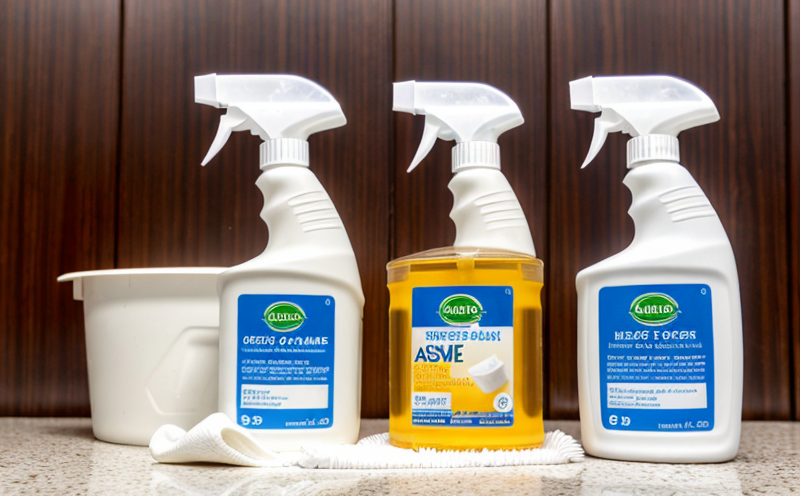ASTM E1838 Virus Suspension Testing of Disinfectants
The ASTM E1838 standard is a critical protocol used to determine the efficacy of disinfectant products against enveloped viruses. This testing method ensures that the products meet stringent requirements for effectiveness, particularly in environments where hygiene and sanitation are paramount.
Enveloped viruses such as influenza A (H1N1), hepatitis C virus, and SARS-CoV-2 are targeted by this test because they depend on their lipid-containing envelopes to maintain stability. The ASTM E1838 procedure involves inoculating a suspension of the target virus into a surface or substrate treated with disinfectant. After incubation, non-inactivated viruses are removed through filtration and quantification via plaque assays or other suitable methods.
This testing is essential for several industries including healthcare facilities, food processing plants, schools, and public transportation systems. Ensuring that disinfectants can effectively inactivate these viruses helps prevent the spread of infections and ensures a safer environment for individuals exposed to potentially contaminated surfaces.
The test protocol specified by ASTM E1838 is designed to be rigorous yet practical. It requires precise control over environmental conditions, including temperature and humidity levels, as well as strict adherence to dosage application rates and contact times recommended by the disinfectant manufacturer.
Understanding the intricacies of this testing method allows stakeholders within various sectors to appreciate its importance in maintaining public health standards. Compliance with ASTM E1838 not only guarantees product efficacy but also builds trust among consumers who rely on these products for protection against harmful pathogens.
- Broad Application: This testing is applicable across multiple industries ranging from healthcare settings to food processing facilities.
- Regulatory Compliance: Meeting ASTM E1838 ensures compliance with relevant regulations governing disinfectant use in different regions worldwide.
- Enhanced Safety: By validating the effectiveness of disinfectants against specific viral targets, this test contributes significantly to improved safety protocols in high-risk environments.
In summary, ASTM E1838 provides a robust framework for evaluating the performance of disinfectant products. Its implementation ensures that these products can effectively neutralize enveloped viruses, thereby enhancing overall hygiene and reducing risk of infection transmission.
Why It Matters
The importance of ASTM E1838 cannot be overstated in today’s world where infectious diseases pose significant threats to public health. Disinfectants play a crucial role in controlling the spread of these pathogens by destroying or inhibiting their growth on surfaces and objects.
Given the complexity of viral structures, particularly those with lipid envelopes like influenza A (H1N1) and SARS-CoV-2, it becomes imperative to have standardized tests that accurately measure a disinfectant’s ability to inactivate these organisms. ASTM E1838 addresses this need by providing clear guidelines on how such evaluations should be conducted.
For healthcare professionals and facility managers, ensuring that the products they use meet stringent standards is paramount. Compliance with ASTM E1838 helps maintain high levels of sanitation within facilities, thus protecting patients, staff, and visitors from potential outbreaks. In addition, manufacturers benefit greatly from demonstrating their product’s effectiveness against specified viral targets, which can enhance brand reputation and consumer confidence.
Moreover, regulatory bodies rely on results derived from ASTM E1838 to set guidelines for the use of disinfectants in various settings. This standardization helps ensure consistency across different jurisdictions while promoting best practices that contribute positively towards global health goals.
In conclusion, ASTM E1838 Virus Suspension Testing of Disinfectants is crucial not only because it ensures product efficacy but also because it promotes safe and effective use of disinfectants in preventing the spread of infectious diseases. Its role in maintaining public health standards cannot be underestimated.
Benefits
- Product Efficacy: Demonstrates that the disinfectant can effectively neutralize enveloped viruses, ensuring reliable performance across different applications.
- Regulatory Compliance: Meeting ASTM E1838 standards allows companies to meet regulatory requirements and avoid potential legal issues related to product safety and efficacy.
- Consumer Confidence: Providing evidence of effective disinfection helps build trust among consumers who are concerned about hygiene and sanitation.
- Innovation: The rigorous nature of ASTM E1838 encourages continuous improvement in formulation development, leading to enhanced product quality over time.
By incorporating ASTM E1838 Virus Suspension Testing into their quality assurance processes, organizations can enhance their reputation and ensure they are contributing positively towards public health objectives.
Quality and Reliability Assurance
The implementation of ASTM E1838 Virus Suspension Testing underscores the commitment to producing reliable and effective disinfectant products. This testing process involves several key steps that contribute to maintaining high standards of quality:
Sample Preparation: Proper preparation ensures accurate representation of real-world usage conditions, allowing for more precise evaluation of a product's performance.
Contact Time and Dosage Application: Adhering strictly to the recommended contact times and application rates is crucial in obtaining meaningful results. Any deviation could lead to underestimation or overestimation of a disinfectant’s efficacy.
Inoculation Process: The method of inoculating the virus suspension must be consistent with established protocols to ensure uniformity across multiple tests. This consistency is vital for replicating study findings and facilitating comparisons between different products.
Post-Test Analysis: Accurate quantification methods, such as plaque assays or similar techniques, are employed to determine the extent of virus inactivation post-treatment. These analyses provide quantitative data that can be used to evaluate product performance objectively.
Incorporating these elements into the testing procedure ensures that every step is meticulously controlled and documented. This approach not only enhances reliability but also fosters transparency throughout the entire evaluation process. Ultimately, this commitment to quality control translates into more trustworthy products capable of delivering consistent results under varied circumstances.





